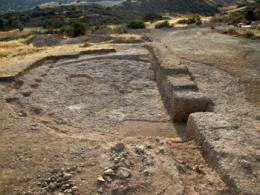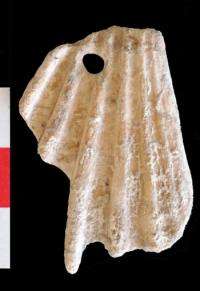The communal building in Klimonas partially excavated. It measures 10 m in diameter. Credit: J.-D. Vigne, CNRS-MNHN. This image is available from the CNRS photo library, phototheque@cnrs-bellevue.fr
The oldest agricultural settlement ever found on a Mediterranean island has been discovered in Cyprus by a team of French archaeologists involving CNRS, the National Museum of Natural History, INRAP, EHESS and the University of Toulouse. Previously it was believed that, due to the island's geographic isolation, the first Neolithic farming societies did not reach Cyprus until a thousand years after the birth of agriculture in the Middle East (ca. 9500 to 9400 BCE). However, the discovery of Klimonas, a village that dates from nearly 9000 years before Christ, proves that early cultivators migrated to Cyprus from the Middle Eastern continent shortly after the emergence of agriculture there, bringing with them wheat as well as dogs and cats.
The findings, which also reveal the early development of maritime navigational skills by these populations, have been published in Proceedings of the National Academy of Science (PNAS).
Sedentary villagers of the Early Neolithic began cultivating wild grains in the Middle East in about 9500 BCE. Recent discoveries have shown that the island of Cyprus was visited by human groups during that period, but until now the earliest traces of cereal crops and the construction of villages did not predate 8400 BCE. The latest findings from the archaeological excavations of Klimonas indicate that organized communities were built in Cyprus between 9100 and 8600 BCE: the site has yielded the remnants of a half-buried mud brick communal building, 10 meters in diameter and surrounded by dwellings, that must have been used to store the village's harvests. The archaeologists have found a few votive offerings inside the building, including flint arrowheads and green stone beads. A great many remnants of other objects, including flint chips, stone tools and shell adornments, have been discovered in the village. The stone tools and the structures erected by these early villagers resemble those found at Neolithic sites from the same period on the nearby continent. Remains of carbonized seeds of local plants and grains introduced from the Levantine coasts (including emmer, one of the first Middle Eastern wheats) have also been found in Klimonas.
Small shell pendant left as an offering in the large communal building of Klimonas. Credit: J.-D. Vigne, CNRS-MNHN. This image is available from the CNRS photo library, phototheque@cnrs-bellevue.fr
An analysis of the bone remains found on the site has revealed that the meat consumed by these villagers came from the hunting of a small wild boar indigenous to Cyprus (the only large game on the island at the time), and that small domestic dogs and cats had been introduced from the continent. This would indicate that these early farming societies migrated from the continent shortly after the emergence of agriculture there. In addition, their ability to move a whole group of people long distances shows that they had already mastered maritime navigation at the dawn of the Neolithic period.
The Klimonas site will be excavated until the end of May 2012, and a new round of excavations will begin in 2013. Uniting several laboratories, the research is funded by CNRS, the European LeCHE project, the Muséum National d'Histoire Naturelle (French National Museum of Natural History, or MNHN), INRAP, the French Ministry of Foreign and European Affairs and the Ecole Française d'Athènes (French School at Athens).
More information: First wave of cultivators spread to Cyprus at least 10,600 y ago. Jean-Denis Vigne, et al. Proceedings of the National Academy of Science, May 7, 2012.
Provided by CNRS





.jpg)

















